Race, Ethnicity, and Migration in the UK: A Report (2013-2017)
VerifiedAdded on 2021/05/26
|15
|4069
|79
Report
AI Summary
This report provides a comprehensive analysis of migration in the UK, focusing on the period between 2013 and 2017. It begins by defining key concepts such as economic migrants, refugees, and asylum seekers, and then explores the historical background of migration to the UK. The report examines the political, public, and governmental reactions to migration, including the impact of Brexit. It delves into theoretical explanations of migration, such as neoclassical and world system theories, and discusses the controversies surrounding migration. The report evaluates policies, practices, and media debates during the specified timeframe and offers recommendations for policy changes. The analysis covers the push and pull factors, the impact of EU membership, and the evolving attitudes towards immigration. Overall, the report offers insights into the complex dynamics of migration and its implications for the UK.
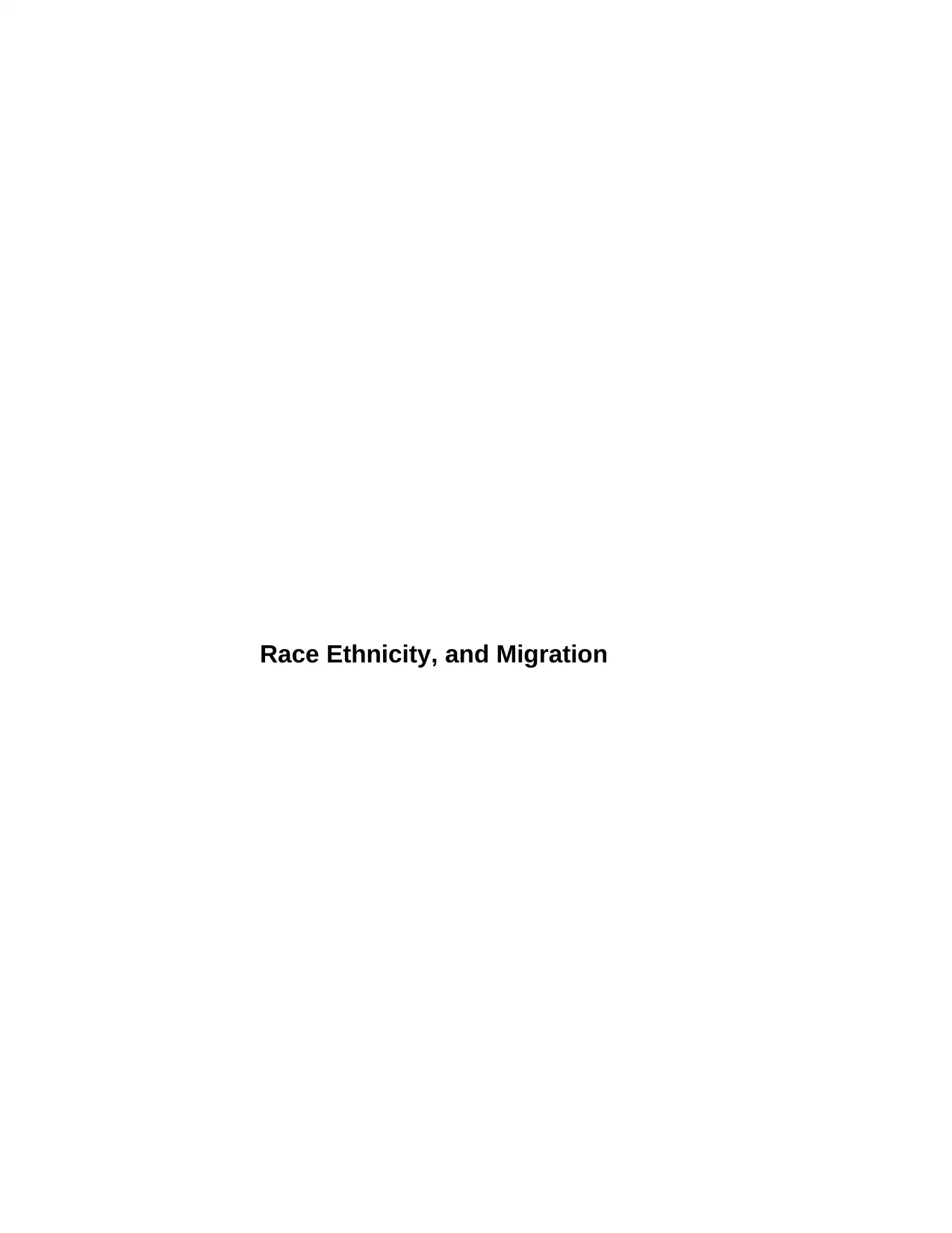
Race Ethnicity, and Migration
Paraphrase This Document
Need a fresh take? Get an instant paraphrase of this document with our AI Paraphraser
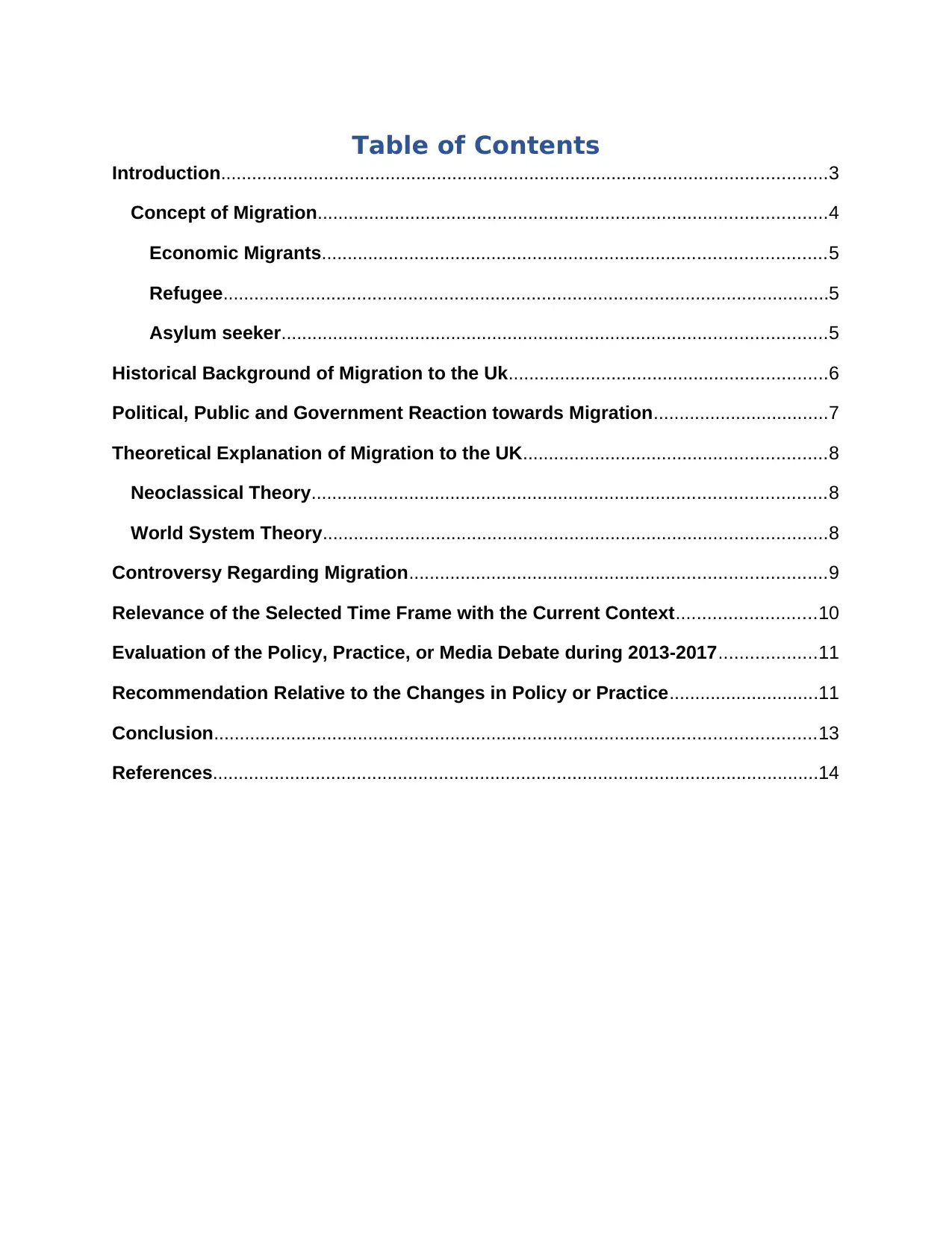
Table of Contents
Introduction......................................................................................................................3
Concept of Migration...................................................................................................4
Economic Migrants..................................................................................................5
Refugee......................................................................................................................5
Asylum seeker..........................................................................................................5
Historical Background of Migration to the Uk..............................................................6
Political, Public and Government Reaction towards Migration..................................7
Theoretical Explanation of Migration to the UK...........................................................8
Neoclassical Theory....................................................................................................8
World System Theory..................................................................................................8
Controversy Regarding Migration.................................................................................9
Relevance of the Selected Time Frame with the Current Context...........................10
Evaluation of the Policy, Practice, or Media Debate during 2013-2017...................11
Recommendation Relative to the Changes in Policy or Practice.............................11
Conclusion.....................................................................................................................13
References......................................................................................................................14
Introduction......................................................................................................................3
Concept of Migration...................................................................................................4
Economic Migrants..................................................................................................5
Refugee......................................................................................................................5
Asylum seeker..........................................................................................................5
Historical Background of Migration to the Uk..............................................................6
Political, Public and Government Reaction towards Migration..................................7
Theoretical Explanation of Migration to the UK...........................................................8
Neoclassical Theory....................................................................................................8
World System Theory..................................................................................................8
Controversy Regarding Migration.................................................................................9
Relevance of the Selected Time Frame with the Current Context...........................10
Evaluation of the Policy, Practice, or Media Debate during 2013-2017...................11
Recommendation Relative to the Changes in Policy or Practice.............................11
Conclusion.....................................................................................................................13
References......................................................................................................................14
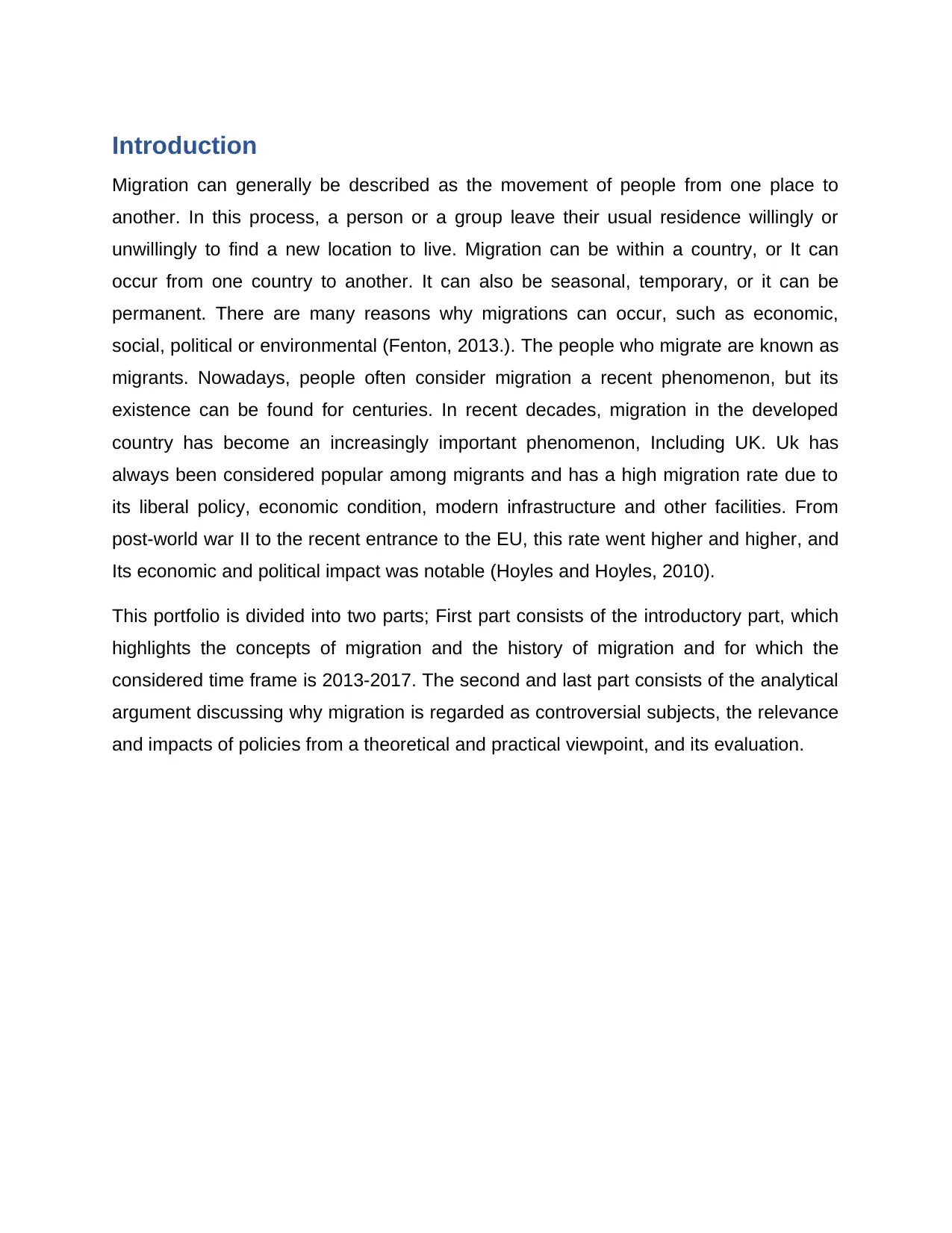
Introduction
Migration can generally be described as the movement of people from one place to
another. In this process, a person or a group leave their usual residence willingly or
unwillingly to find a new location to live. Migration can be within a country, or It can
occur from one country to another. It can also be seasonal, temporary, or it can be
permanent. There are many reasons why migrations can occur, such as economic,
social, political or environmental (Fenton, 2013.). The people who migrate are known as
migrants. Nowadays, people often consider migration a recent phenomenon, but its
existence can be found for centuries. In recent decades, migration in the developed
country has become an increasingly important phenomenon, Including UK. Uk has
always been considered popular among migrants and has a high migration rate due to
its liberal policy, economic condition, modern infrastructure and other facilities. From
post-world war II to the recent entrance to the EU, this rate went higher and higher, and
Its economic and political impact was notable (Hoyles and Hoyles, 2010).
This portfolio is divided into two parts; First part consists of the introductory part, which
highlights the concepts of migration and the history of migration and for which the
considered time frame is 2013-2017. The second and last part consists of the analytical
argument discussing why migration is regarded as controversial subjects, the relevance
and impacts of policies from a theoretical and practical viewpoint, and its evaluation.
Migration can generally be described as the movement of people from one place to
another. In this process, a person or a group leave their usual residence willingly or
unwillingly to find a new location to live. Migration can be within a country, or It can
occur from one country to another. It can also be seasonal, temporary, or it can be
permanent. There are many reasons why migrations can occur, such as economic,
social, political or environmental (Fenton, 2013.). The people who migrate are known as
migrants. Nowadays, people often consider migration a recent phenomenon, but its
existence can be found for centuries. In recent decades, migration in the developed
country has become an increasingly important phenomenon, Including UK. Uk has
always been considered popular among migrants and has a high migration rate due to
its liberal policy, economic condition, modern infrastructure and other facilities. From
post-world war II to the recent entrance to the EU, this rate went higher and higher, and
Its economic and political impact was notable (Hoyles and Hoyles, 2010).
This portfolio is divided into two parts; First part consists of the introductory part, which
highlights the concepts of migration and the history of migration and for which the
considered time frame is 2013-2017. The second and last part consists of the analytical
argument discussing why migration is regarded as controversial subjects, the relevance
and impacts of policies from a theoretical and practical viewpoint, and its evaluation.
⊘ This is a preview!⊘
Do you want full access?
Subscribe today to unlock all pages.

Trusted by 1+ million students worldwide
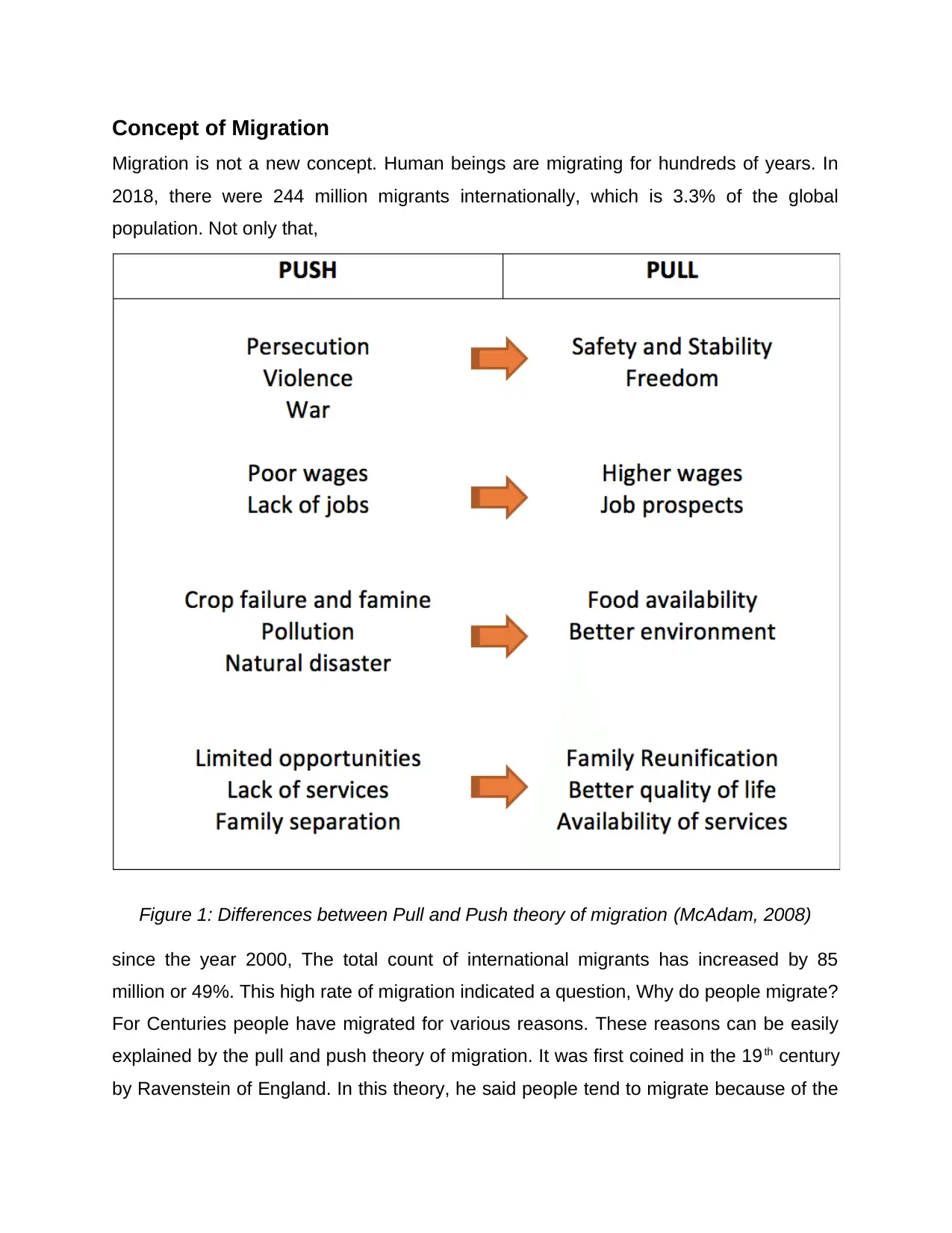
Concept of Migration
Migration is not a new concept. Human beings are migrating for hundreds of years. In
2018, there were 244 million migrants internationally, which is 3.3% of the global
population. Not only that,
Figure 1: Differences between Pull and Push theory of migration (McAdam, 2008)
since the year 2000, The total count of international migrants has increased by 85
million or 49%. This high rate of migration indicated a question, Why do people migrate?
For Centuries people have migrated for various reasons. These reasons can be easily
explained by the pull and push theory of migration. It was first coined in the 19th century
by Ravenstein of England. In this theory, he said people tend to migrate because of the
Migration is not a new concept. Human beings are migrating for hundreds of years. In
2018, there were 244 million migrants internationally, which is 3.3% of the global
population. Not only that,
Figure 1: Differences between Pull and Push theory of migration (McAdam, 2008)
since the year 2000, The total count of international migrants has increased by 85
million or 49%. This high rate of migration indicated a question, Why do people migrate?
For Centuries people have migrated for various reasons. These reasons can be easily
explained by the pull and push theory of migration. It was first coined in the 19th century
by Ravenstein of England. In this theory, he said people tend to migrate because of the
Paraphrase This Document
Need a fresh take? Get an instant paraphrase of this document with our AI Paraphraser
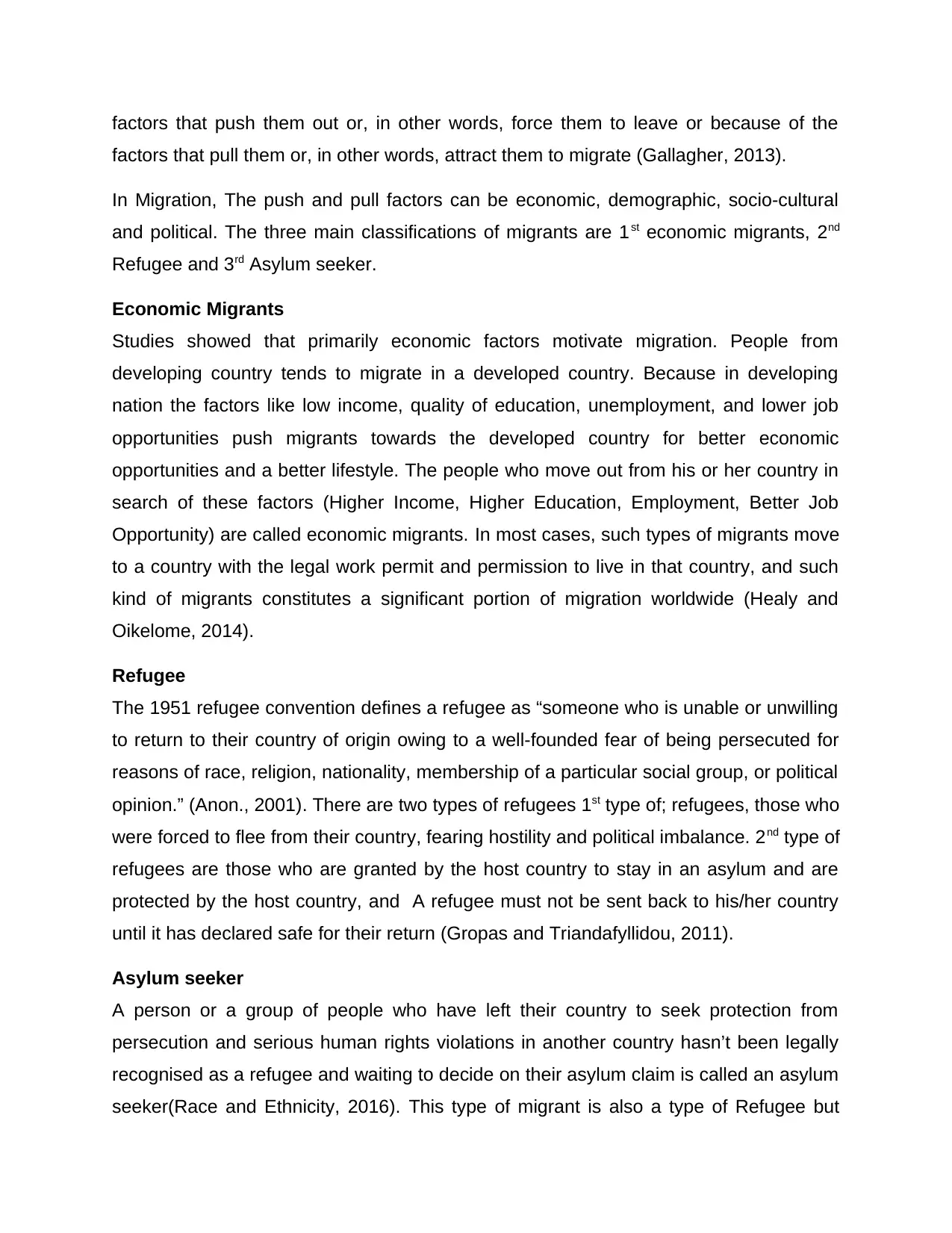
factors that push them out or, in other words, force them to leave or because of the
factors that pull them or, in other words, attract them to migrate (Gallagher, 2013).
In Migration, The push and pull factors can be economic, demographic, socio-cultural
and political. The three main classifications of migrants are 1st economic migrants, 2nd
Refugee and 3rd Asylum seeker.
Economic Migrants
Studies showed that primarily economic factors motivate migration. People from
developing country tends to migrate in a developed country. Because in developing
nation the factors like low income, quality of education, unemployment, and lower job
opportunities push migrants towards the developed country for better economic
opportunities and a better lifestyle. The people who move out from his or her country in
search of these factors (Higher Income, Higher Education, Employment, Better Job
Opportunity) are called economic migrants. In most cases, such types of migrants move
to a country with the legal work permit and permission to live in that country, and such
kind of migrants constitutes a significant portion of migration worldwide (Healy and
Oikelome, 2014).
Refugee
The 1951 refugee convention defines a refugee as “someone who is unable or unwilling
to return to their country of origin owing to a well-founded fear of being persecuted for
reasons of race, religion, nationality, membership of a particular social group, or political
opinion.” (Anon., 2001). There are two types of refugees 1st type of; refugees, those who
were forced to flee from their country, fearing hostility and political imbalance. 2nd type of
refugees are those who are granted by the host country to stay in an asylum and are
protected by the host country, and A refugee must not be sent back to his/her country
until it has declared safe for their return (Gropas and Triandafyllidou, 2011).
Asylum seeker
A person or a group of people who have left their country to seek protection from
persecution and serious human rights violations in another country hasn’t been legally
recognised as a refugee and waiting to decide on their asylum claim is called an asylum
seeker(Race and Ethnicity, 2016). This type of migrant is also a type of Refugee but
factors that pull them or, in other words, attract them to migrate (Gallagher, 2013).
In Migration, The push and pull factors can be economic, demographic, socio-cultural
and political. The three main classifications of migrants are 1st economic migrants, 2nd
Refugee and 3rd Asylum seeker.
Economic Migrants
Studies showed that primarily economic factors motivate migration. People from
developing country tends to migrate in a developed country. Because in developing
nation the factors like low income, quality of education, unemployment, and lower job
opportunities push migrants towards the developed country for better economic
opportunities and a better lifestyle. The people who move out from his or her country in
search of these factors (Higher Income, Higher Education, Employment, Better Job
Opportunity) are called economic migrants. In most cases, such types of migrants move
to a country with the legal work permit and permission to live in that country, and such
kind of migrants constitutes a significant portion of migration worldwide (Healy and
Oikelome, 2014).
Refugee
The 1951 refugee convention defines a refugee as “someone who is unable or unwilling
to return to their country of origin owing to a well-founded fear of being persecuted for
reasons of race, religion, nationality, membership of a particular social group, or political
opinion.” (Anon., 2001). There are two types of refugees 1st type of; refugees, those who
were forced to flee from their country, fearing hostility and political imbalance. 2nd type of
refugees are those who are granted by the host country to stay in an asylum and are
protected by the host country, and A refugee must not be sent back to his/her country
until it has declared safe for their return (Gropas and Triandafyllidou, 2011).
Asylum seeker
A person or a group of people who have left their country to seek protection from
persecution and serious human rights violations in another country hasn’t been legally
recognised as a refugee and waiting to decide on their asylum claim is called an asylum
seeker(Race and Ethnicity, 2016). This type of migrant is also a type of Refugee but
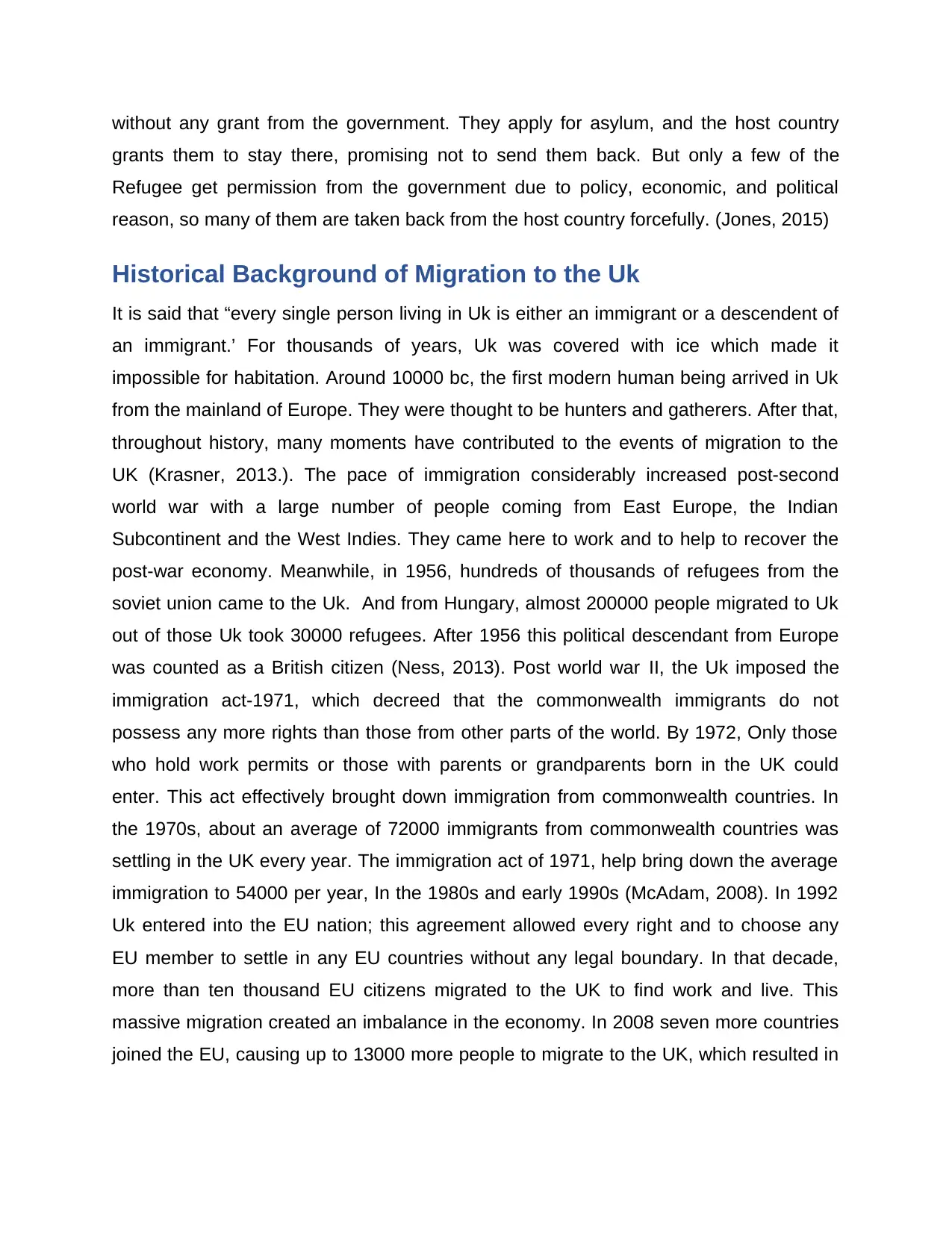
without any grant from the government. They apply for asylum, and the host country
grants them to stay there, promising not to send them back. But only a few of the
Refugee get permission from the government due to policy, economic, and political
reason, so many of them are taken back from the host country forcefully. (Jones, 2015)
Historical Background of Migration to the Uk
It is said that “every single person living in Uk is either an immigrant or a descendent of
an immigrant.’ For thousands of years, Uk was covered with ice which made it
impossible for habitation. Around 10000 bc, the first modern human being arrived in Uk
from the mainland of Europe. They were thought to be hunters and gatherers. After that,
throughout history, many moments have contributed to the events of migration to the
UK (Krasner, 2013.). The pace of immigration considerably increased post-second
world war with a large number of people coming from East Europe, the Indian
Subcontinent and the West Indies. They came here to work and to help to recover the
post-war economy. Meanwhile, in 1956, hundreds of thousands of refugees from the
soviet union came to the Uk. And from Hungary, almost 200000 people migrated to Uk
out of those Uk took 30000 refugees. After 1956 this political descendant from Europe
was counted as a British citizen (Ness, 2013). Post world war II, the Uk imposed the
immigration act-1971, which decreed that the commonwealth immigrants do not
possess any more rights than those from other parts of the world. By 1972, Only those
who hold work permits or those with parents or grandparents born in the UK could
enter. This act effectively brought down immigration from commonwealth countries. In
the 1970s, about an average of 72000 immigrants from commonwealth countries was
settling in the UK every year. The immigration act of 1971, help bring down the average
immigration to 54000 per year, In the 1980s and early 1990s (McAdam, 2008). In 1992
Uk entered into the EU nation; this agreement allowed every right and to choose any
EU member to settle in any EU countries without any legal boundary. In that decade,
more than ten thousand EU citizens migrated to the UK to find work and live. This
massive migration created an imbalance in the economy. In 2008 seven more countries
joined the EU, causing up to 13000 more people to migrate to the UK, which resulted in
grants them to stay there, promising not to send them back. But only a few of the
Refugee get permission from the government due to policy, economic, and political
reason, so many of them are taken back from the host country forcefully. (Jones, 2015)
Historical Background of Migration to the Uk
It is said that “every single person living in Uk is either an immigrant or a descendent of
an immigrant.’ For thousands of years, Uk was covered with ice which made it
impossible for habitation. Around 10000 bc, the first modern human being arrived in Uk
from the mainland of Europe. They were thought to be hunters and gatherers. After that,
throughout history, many moments have contributed to the events of migration to the
UK (Krasner, 2013.). The pace of immigration considerably increased post-second
world war with a large number of people coming from East Europe, the Indian
Subcontinent and the West Indies. They came here to work and to help to recover the
post-war economy. Meanwhile, in 1956, hundreds of thousands of refugees from the
soviet union came to the Uk. And from Hungary, almost 200000 people migrated to Uk
out of those Uk took 30000 refugees. After 1956 this political descendant from Europe
was counted as a British citizen (Ness, 2013). Post world war II, the Uk imposed the
immigration act-1971, which decreed that the commonwealth immigrants do not
possess any more rights than those from other parts of the world. By 1972, Only those
who hold work permits or those with parents or grandparents born in the UK could
enter. This act effectively brought down immigration from commonwealth countries. In
the 1970s, about an average of 72000 immigrants from commonwealth countries was
settling in the UK every year. The immigration act of 1971, help bring down the average
immigration to 54000 per year, In the 1980s and early 1990s (McAdam, 2008). In 1992
Uk entered into the EU nation; this agreement allowed every right and to choose any
EU member to settle in any EU countries without any legal boundary. In that decade,
more than ten thousand EU citizens migrated to the UK to find work and live. This
massive migration created an imbalance in the economy. In 2008 seven more countries
joined the EU, causing up to 13000 more people to migrate to the UK, which resulted in
⊘ This is a preview!⊘
Do you want full access?
Subscribe today to unlock all pages.

Trusted by 1+ million students worldwide
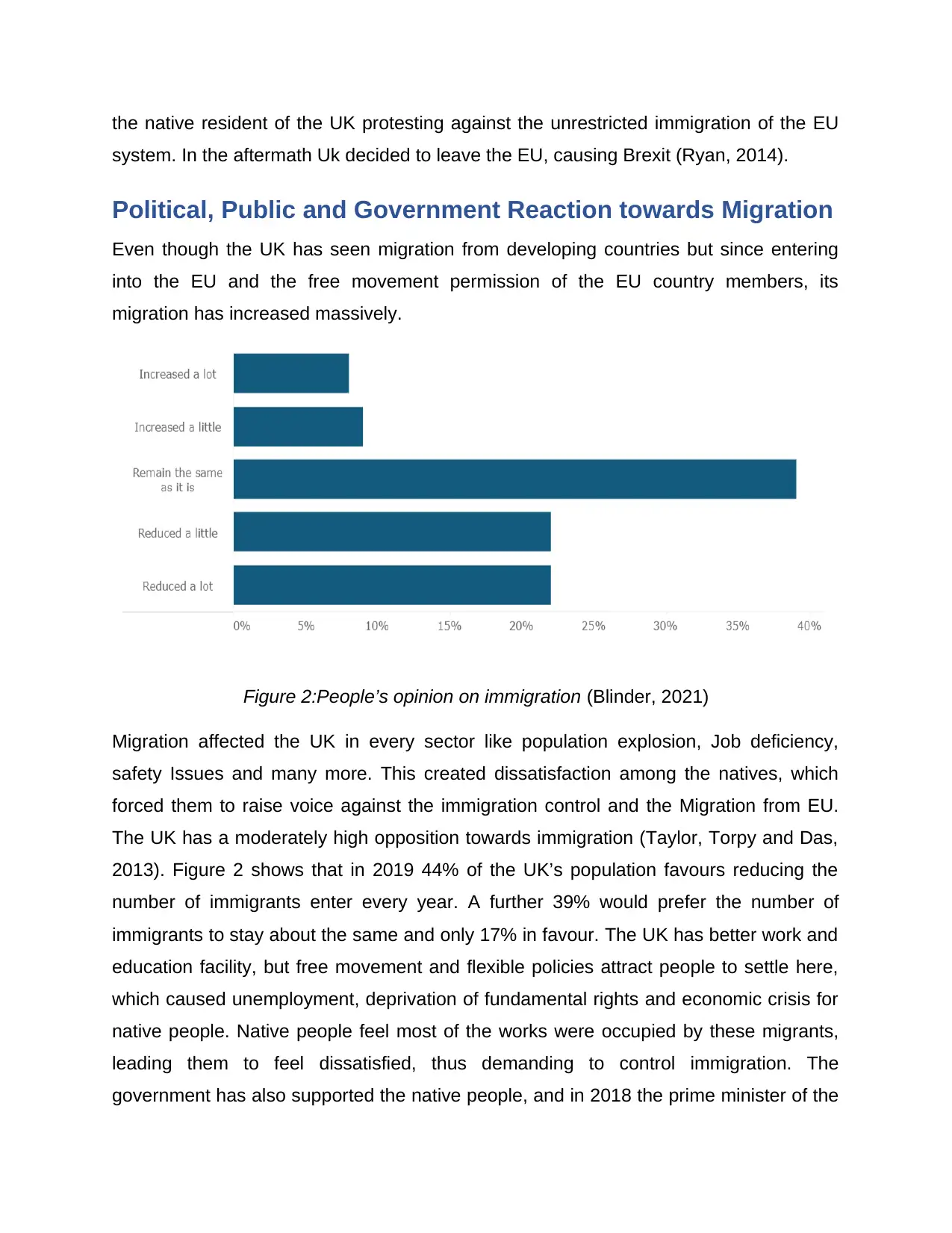
the native resident of the UK protesting against the unrestricted immigration of the EU
system. In the aftermath Uk decided to leave the EU, causing Brexit (Ryan, 2014).
Political, Public and Government Reaction towards Migration
Even though the UK has seen migration from developing countries but since entering
into the EU and the free movement permission of the EU country members, its
migration has increased massively.
Figure 2:People’s opinion on immigration (Blinder, 2021)
Migration affected the UK in every sector like population explosion, Job deficiency,
safety Issues and many more. This created dissatisfaction among the natives, which
forced them to raise voice against the immigration control and the Migration from EU.
The UK has a moderately high opposition towards immigration (Taylor, Torpy and Das,
2013). Figure 2 shows that in 2019 44% of the UK’s population favours reducing the
number of immigrants enter every year. A further 39% would prefer the number of
immigrants to stay about the same and only 17% in favour. The UK has better work and
education facility, but free movement and flexible policies attract people to settle here,
which caused unemployment, deprivation of fundamental rights and economic crisis for
native people. Native people feel most of the works were occupied by these migrants,
leading them to feel dissatisfied, thus demanding to control immigration. The
government has also supported the native people, and in 2018 the prime minister of the
system. In the aftermath Uk decided to leave the EU, causing Brexit (Ryan, 2014).
Political, Public and Government Reaction towards Migration
Even though the UK has seen migration from developing countries but since entering
into the EU and the free movement permission of the EU country members, its
migration has increased massively.
Figure 2:People’s opinion on immigration (Blinder, 2021)
Migration affected the UK in every sector like population explosion, Job deficiency,
safety Issues and many more. This created dissatisfaction among the natives, which
forced them to raise voice against the immigration control and the Migration from EU.
The UK has a moderately high opposition towards immigration (Taylor, Torpy and Das,
2013). Figure 2 shows that in 2019 44% of the UK’s population favours reducing the
number of immigrants enter every year. A further 39% would prefer the number of
immigrants to stay about the same and only 17% in favour. The UK has better work and
education facility, but free movement and flexible policies attract people to settle here,
which caused unemployment, deprivation of fundamental rights and economic crisis for
native people. Native people feel most of the works were occupied by these migrants,
leading them to feel dissatisfied, thus demanding to control immigration. The
government has also supported the native people, and in 2018 the prime minister of the
Paraphrase This Document
Need a fresh take? Get an instant paraphrase of this document with our AI Paraphraser
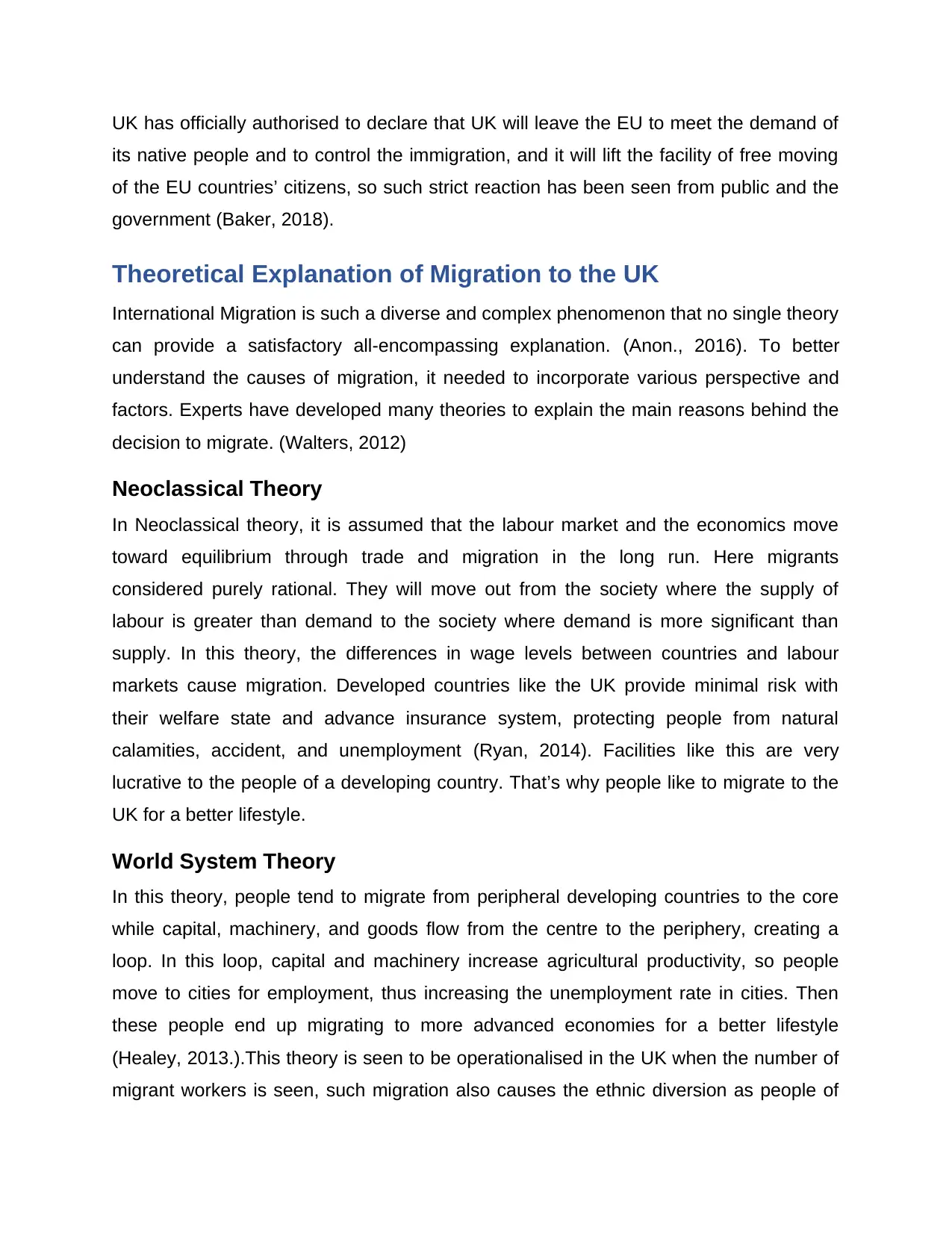
UK has officially authorised to declare that UK will leave the EU to meet the demand of
its native people and to control the immigration, and it will lift the facility of free moving
of the EU countries’ citizens, so such strict reaction has been seen from public and the
government (Baker, 2018).
Theoretical Explanation of Migration to the UK
International Migration is such a diverse and complex phenomenon that no single theory
can provide a satisfactory all-encompassing explanation. (Anon., 2016). To better
understand the causes of migration, it needed to incorporate various perspective and
factors. Experts have developed many theories to explain the main reasons behind the
decision to migrate. (Walters, 2012)
Neoclassical Theory
In Neoclassical theory, it is assumed that the labour market and the economics move
toward equilibrium through trade and migration in the long run. Here migrants
considered purely rational. They will move out from the society where the supply of
labour is greater than demand to the society where demand is more significant than
supply. In this theory, the differences in wage levels between countries and labour
markets cause migration. Developed countries like the UK provide minimal risk with
their welfare state and advance insurance system, protecting people from natural
calamities, accident, and unemployment (Ryan, 2014). Facilities like this are very
lucrative to the people of a developing country. That’s why people like to migrate to the
UK for a better lifestyle.
World System Theory
In this theory, people tend to migrate from peripheral developing countries to the core
while capital, machinery, and goods flow from the centre to the periphery, creating a
loop. In this loop, capital and machinery increase agricultural productivity, so people
move to cities for employment, thus increasing the unemployment rate in cities. Then
these people end up migrating to more advanced economies for a better lifestyle
(Healey, 2013.).This theory is seen to be operationalised in the UK when the number of
migrant workers is seen, such migration also causes the ethnic diversion as people of
its native people and to control the immigration, and it will lift the facility of free moving
of the EU countries’ citizens, so such strict reaction has been seen from public and the
government (Baker, 2018).
Theoretical Explanation of Migration to the UK
International Migration is such a diverse and complex phenomenon that no single theory
can provide a satisfactory all-encompassing explanation. (Anon., 2016). To better
understand the causes of migration, it needed to incorporate various perspective and
factors. Experts have developed many theories to explain the main reasons behind the
decision to migrate. (Walters, 2012)
Neoclassical Theory
In Neoclassical theory, it is assumed that the labour market and the economics move
toward equilibrium through trade and migration in the long run. Here migrants
considered purely rational. They will move out from the society where the supply of
labour is greater than demand to the society where demand is more significant than
supply. In this theory, the differences in wage levels between countries and labour
markets cause migration. Developed countries like the UK provide minimal risk with
their welfare state and advance insurance system, protecting people from natural
calamities, accident, and unemployment (Ryan, 2014). Facilities like this are very
lucrative to the people of a developing country. That’s why people like to migrate to the
UK for a better lifestyle.
World System Theory
In this theory, people tend to migrate from peripheral developing countries to the core
while capital, machinery, and goods flow from the centre to the periphery, creating a
loop. In this loop, capital and machinery increase agricultural productivity, so people
move to cities for employment, thus increasing the unemployment rate in cities. Then
these people end up migrating to more advanced economies for a better lifestyle
(Healey, 2013.).This theory is seen to be operationalised in the UK when the number of
migrant workers is seen, such migration also causes the ethnic diversion as people of
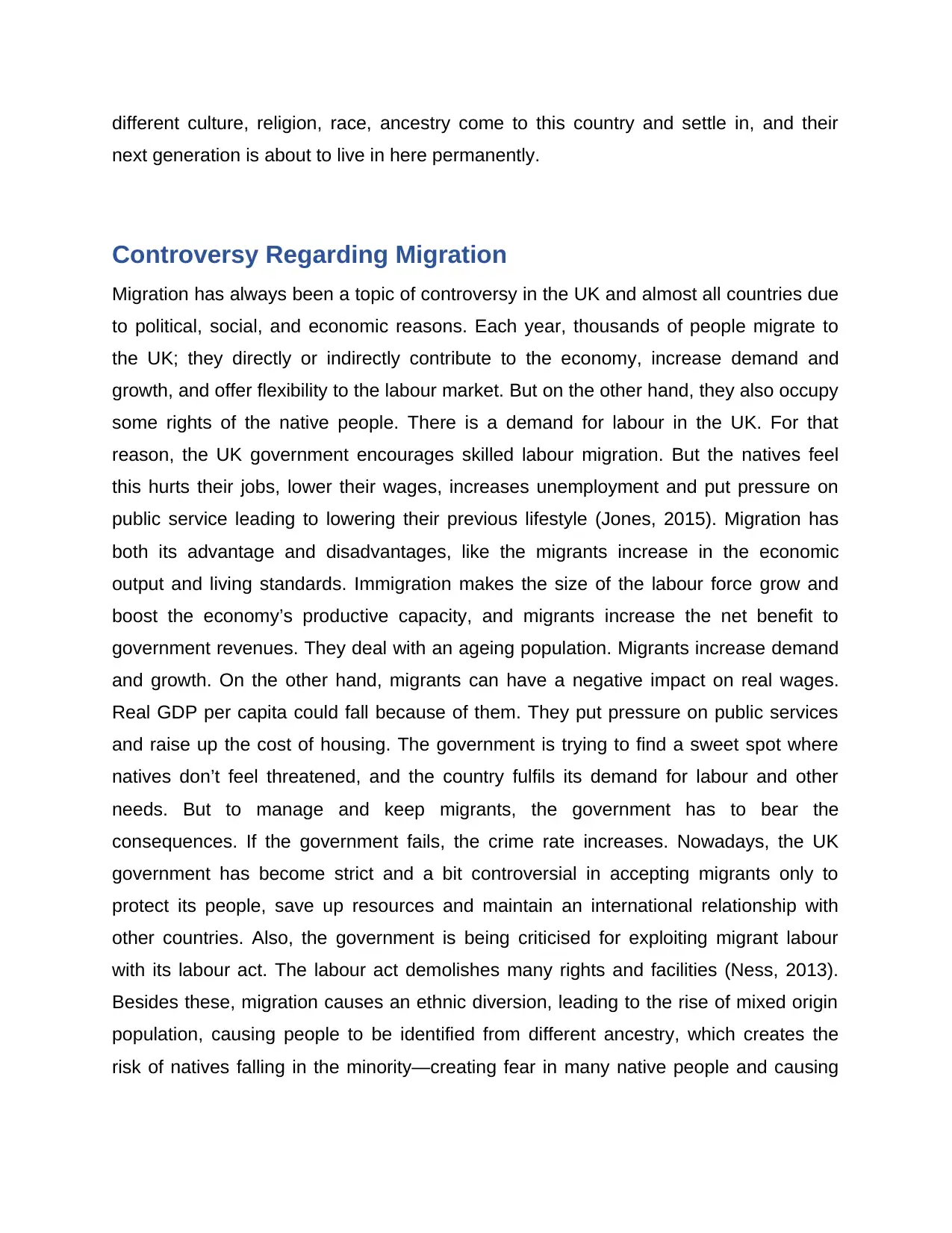
different culture, religion, race, ancestry come to this country and settle in, and their
next generation is about to live in here permanently.
Controversy Regarding Migration
Migration has always been a topic of controversy in the UK and almost all countries due
to political, social, and economic reasons. Each year, thousands of people migrate to
the UK; they directly or indirectly contribute to the economy, increase demand and
growth, and offer flexibility to the labour market. But on the other hand, they also occupy
some rights of the native people. There is a demand for labour in the UK. For that
reason, the UK government encourages skilled labour migration. But the natives feel
this hurts their jobs, lower their wages, increases unemployment and put pressure on
public service leading to lowering their previous lifestyle (Jones, 2015). Migration has
both its advantage and disadvantages, like the migrants increase in the economic
output and living standards. Immigration makes the size of the labour force grow and
boost the economy’s productive capacity, and migrants increase the net benefit to
government revenues. They deal with an ageing population. Migrants increase demand
and growth. On the other hand, migrants can have a negative impact on real wages.
Real GDP per capita could fall because of them. They put pressure on public services
and raise up the cost of housing. The government is trying to find a sweet spot where
natives don’t feel threatened, and the country fulfils its demand for labour and other
needs. But to manage and keep migrants, the government has to bear the
consequences. If the government fails, the crime rate increases. Nowadays, the UK
government has become strict and a bit controversial in accepting migrants only to
protect its people, save up resources and maintain an international relationship with
other countries. Also, the government is being criticised for exploiting migrant labour
with its labour act. The labour act demolishes many rights and facilities (Ness, 2013).
Besides these, migration causes an ethnic diversion, leading to the rise of mixed origin
population, causing people to be identified from different ancestry, which creates the
risk of natives falling in the minority—creating fear in many native people and causing
next generation is about to live in here permanently.
Controversy Regarding Migration
Migration has always been a topic of controversy in the UK and almost all countries due
to political, social, and economic reasons. Each year, thousands of people migrate to
the UK; they directly or indirectly contribute to the economy, increase demand and
growth, and offer flexibility to the labour market. But on the other hand, they also occupy
some rights of the native people. There is a demand for labour in the UK. For that
reason, the UK government encourages skilled labour migration. But the natives feel
this hurts their jobs, lower their wages, increases unemployment and put pressure on
public service leading to lowering their previous lifestyle (Jones, 2015). Migration has
both its advantage and disadvantages, like the migrants increase in the economic
output and living standards. Immigration makes the size of the labour force grow and
boost the economy’s productive capacity, and migrants increase the net benefit to
government revenues. They deal with an ageing population. Migrants increase demand
and growth. On the other hand, migrants can have a negative impact on real wages.
Real GDP per capita could fall because of them. They put pressure on public services
and raise up the cost of housing. The government is trying to find a sweet spot where
natives don’t feel threatened, and the country fulfils its demand for labour and other
needs. But to manage and keep migrants, the government has to bear the
consequences. If the government fails, the crime rate increases. Nowadays, the UK
government has become strict and a bit controversial in accepting migrants only to
protect its people, save up resources and maintain an international relationship with
other countries. Also, the government is being criticised for exploiting migrant labour
with its labour act. The labour act demolishes many rights and facilities (Ness, 2013).
Besides these, migration causes an ethnic diversion, leading to the rise of mixed origin
population, causing people to be identified from different ancestry, which creates the
risk of natives falling in the minority—creating fear in many native people and causing
⊘ This is a preview!⊘
Do you want full access?
Subscribe today to unlock all pages.

Trusted by 1+ million students worldwide
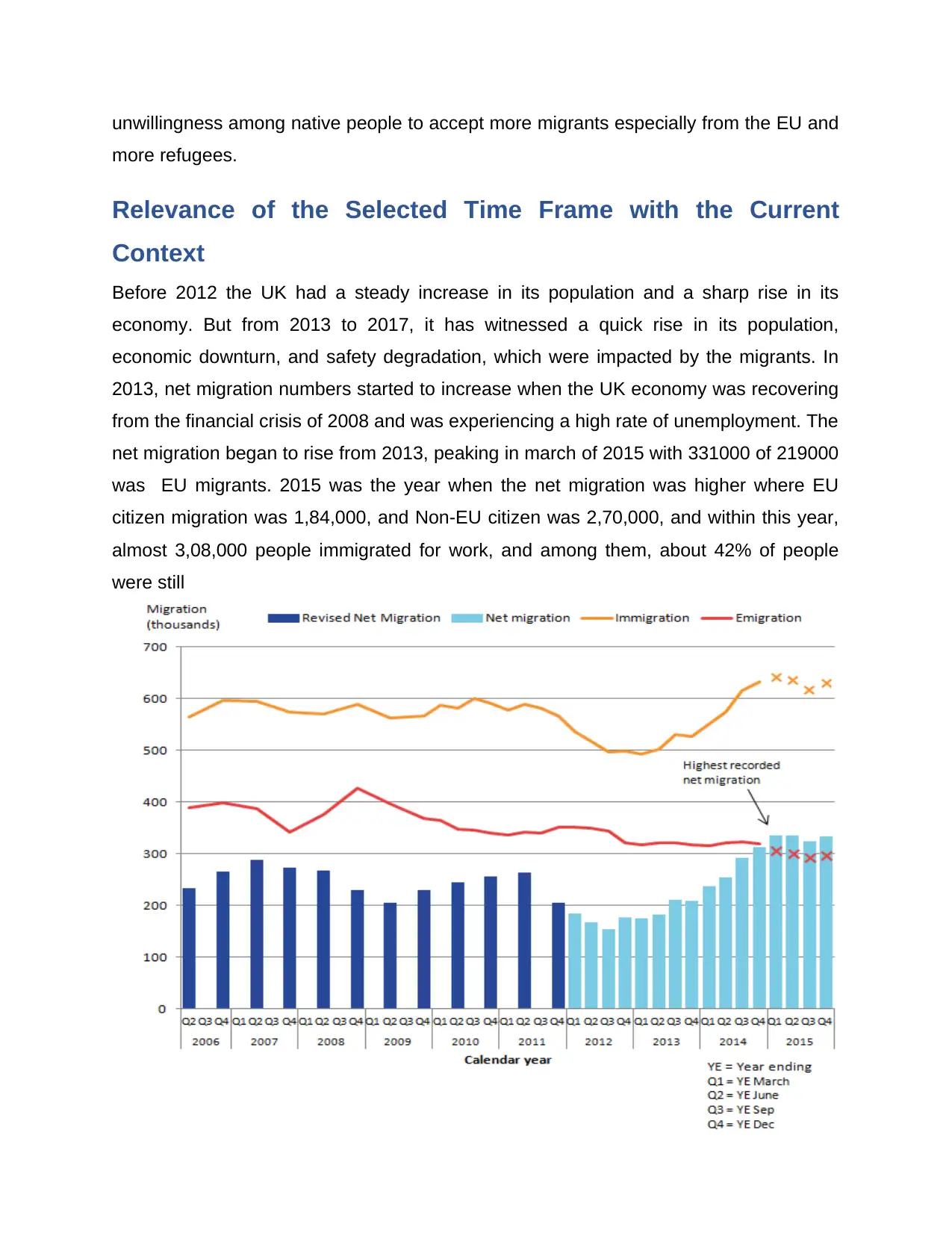
unwillingness among native people to accept more migrants especially from the EU and
more refugees.
Relevance of the Selected Time Frame with the Current
Context
Before 2012 the UK had a steady increase in its population and a sharp rise in its
economy. But from 2013 to 2017, it has witnessed a quick rise in its population,
economic downturn, and safety degradation, which were impacted by the migrants. In
2013, net migration numbers started to increase when the UK economy was recovering
from the financial crisis of 2008 and was experiencing a high rate of unemployment. The
net migration began to rise from 2013, peaking in march of 2015 with 331000 of 219000
was EU migrants. 2015 was the year when the net migration was higher where EU
citizen migration was 1,84,000, and Non-EU citizen was 2,70,000, and within this year,
almost 3,08,000 people immigrated for work, and among them, about 42% of people
were still
more refugees.
Relevance of the Selected Time Frame with the Current
Context
Before 2012 the UK had a steady increase in its population and a sharp rise in its
economy. But from 2013 to 2017, it has witnessed a quick rise in its population,
economic downturn, and safety degradation, which were impacted by the migrants. In
2013, net migration numbers started to increase when the UK economy was recovering
from the financial crisis of 2008 and was experiencing a high rate of unemployment. The
net migration began to rise from 2013, peaking in march of 2015 with 331000 of 219000
was EU migrants. 2015 was the year when the net migration was higher where EU
citizen migration was 1,84,000, and Non-EU citizen was 2,70,000, and within this year,
almost 3,08,000 people immigrated for work, and among them, about 42% of people
were still
Paraphrase This Document
Need a fresh take? Get an instant paraphrase of this document with our AI Paraphraser

Figure 3: Long-term Migration Trend (Office for National Statistics, 2016)
unemployed, and the rest of the 58% people had a permanent job (Office for National
Statistics, 2016).
Because of such an immense increase in migration, the nation was facing pressure on
the job field, resident, food security and overall social-economic condition, driving the
native people to demand their rights over the migrants, which lead the UK to declare
Brexit. With the declaration of Brexit, the UK eliminated the easy movement the EU
countries. The estimated EU-born population is slightly lower in 2018 and 2019 than in
2017. Besides, the government has also planned to introduce a point-based scheme for
the migrants so that only the skilled people can get the chance to move to the UK and
can contribute to its economy. Such a decision may also affect the economic theory and
world system theory as many low-skilled workers won’t be able to migrate to the UK that
will also impact the diversion of ethnicity.
Evaluation of the Policy, Practice, or Media Debate during
2013-2017
The declaration of Brexit and to change the policy of migration would have a control on
the net migration and also on the independence of decision making as earlier UK has to
abide by the rules of the EU in terms of trade and the movement of its citizens (Ian
Fitzgerald, 2012). From the year 2012-2016, The UK saw massive ethnic diverseness
and the degradation of security and the economy. In 2016, the UK government officially
took the decision to declare Brexit. After departing from the EU, the UK will have to pay
additional traffic on import of supermarket Items as 43% drink, 21% fruit and vegetable,
14% fish and meat, and 7% on cereals which are imported from the EU. Brexit may also
be the cause of the UK’s reduced political power in world politics. But the residents now
will get more opportunity in every sector as there will be fewer EU migrants.
unemployed, and the rest of the 58% people had a permanent job (Office for National
Statistics, 2016).
Because of such an immense increase in migration, the nation was facing pressure on
the job field, resident, food security and overall social-economic condition, driving the
native people to demand their rights over the migrants, which lead the UK to declare
Brexit. With the declaration of Brexit, the UK eliminated the easy movement the EU
countries. The estimated EU-born population is slightly lower in 2018 and 2019 than in
2017. Besides, the government has also planned to introduce a point-based scheme for
the migrants so that only the skilled people can get the chance to move to the UK and
can contribute to its economy. Such a decision may also affect the economic theory and
world system theory as many low-skilled workers won’t be able to migrate to the UK that
will also impact the diversion of ethnicity.
Evaluation of the Policy, Practice, or Media Debate during
2013-2017
The declaration of Brexit and to change the policy of migration would have a control on
the net migration and also on the independence of decision making as earlier UK has to
abide by the rules of the EU in terms of trade and the movement of its citizens (Ian
Fitzgerald, 2012). From the year 2012-2016, The UK saw massive ethnic diverseness
and the degradation of security and the economy. In 2016, the UK government officially
took the decision to declare Brexit. After departing from the EU, the UK will have to pay
additional traffic on import of supermarket Items as 43% drink, 21% fruit and vegetable,
14% fish and meat, and 7% on cereals which are imported from the EU. Brexit may also
be the cause of the UK’s reduced political power in world politics. But the residents now
will get more opportunity in every sector as there will be fewer EU migrants.

Recommendation Relative to the Changes in Policy or
Practice
With Brexit, the Uk has gained full control over its migration. Immigration policy should
be focusing on economic questions. The UK economy needs and has always have
been benefited from the work of highly skilled immigrants. But the government must
ensure that highly skilled labour should be encouraged to apply for migration with
facilities and rights (Zamora, 2016). Also, to make things easy, the Uk should simplify
the current overcomplicated work permit system. and it should also reinstate the higher
skills threshold and introduce a certain salary requirement for work permits. Migrants
have always been a high contributor to the UK economy. The UK should also focus on
medium and low skilled labour forces because they also need to be taken into account;
otherwise, there could be a shortage. There should not be any regional salary variation
because such variation also motivates people to leave the region and move into others
for better remuneration. Also, the UK should emphasise encouraging education-based
migration as it is one of the UK’s major earning sectors. Family reunion and chain
migration is the largest category by which immigrants are settling permanently. This
category covers the sponsoring of partners, parents and other family members to come
over to live in the UK. To keep migration in control through this category, the UK should
impose minimum income requirements for sponsoring spouses. Higher age requirement
for sponsoring spouses. If these recommendations are taken into consideration, the UK
will get better control over its migration, resulting in the betterment of the county’s
economy.
Practice
With Brexit, the Uk has gained full control over its migration. Immigration policy should
be focusing on economic questions. The UK economy needs and has always have
been benefited from the work of highly skilled immigrants. But the government must
ensure that highly skilled labour should be encouraged to apply for migration with
facilities and rights (Zamora, 2016). Also, to make things easy, the Uk should simplify
the current overcomplicated work permit system. and it should also reinstate the higher
skills threshold and introduce a certain salary requirement for work permits. Migrants
have always been a high contributor to the UK economy. The UK should also focus on
medium and low skilled labour forces because they also need to be taken into account;
otherwise, there could be a shortage. There should not be any regional salary variation
because such variation also motivates people to leave the region and move into others
for better remuneration. Also, the UK should emphasise encouraging education-based
migration as it is one of the UK’s major earning sectors. Family reunion and chain
migration is the largest category by which immigrants are settling permanently. This
category covers the sponsoring of partners, parents and other family members to come
over to live in the UK. To keep migration in control through this category, the UK should
impose minimum income requirements for sponsoring spouses. Higher age requirement
for sponsoring spouses. If these recommendations are taken into consideration, the UK
will get better control over its migration, resulting in the betterment of the county’s
economy.
⊘ This is a preview!⊘
Do you want full access?
Subscribe today to unlock all pages.

Trusted by 1+ million students worldwide
1 out of 15
Related Documents
Your All-in-One AI-Powered Toolkit for Academic Success.
+13062052269
info@desklib.com
Available 24*7 on WhatsApp / Email
![[object Object]](/_next/static/media/star-bottom.7253800d.svg)
Unlock your academic potential
Copyright © 2020–2025 A2Z Services. All Rights Reserved. Developed and managed by ZUCOL.





